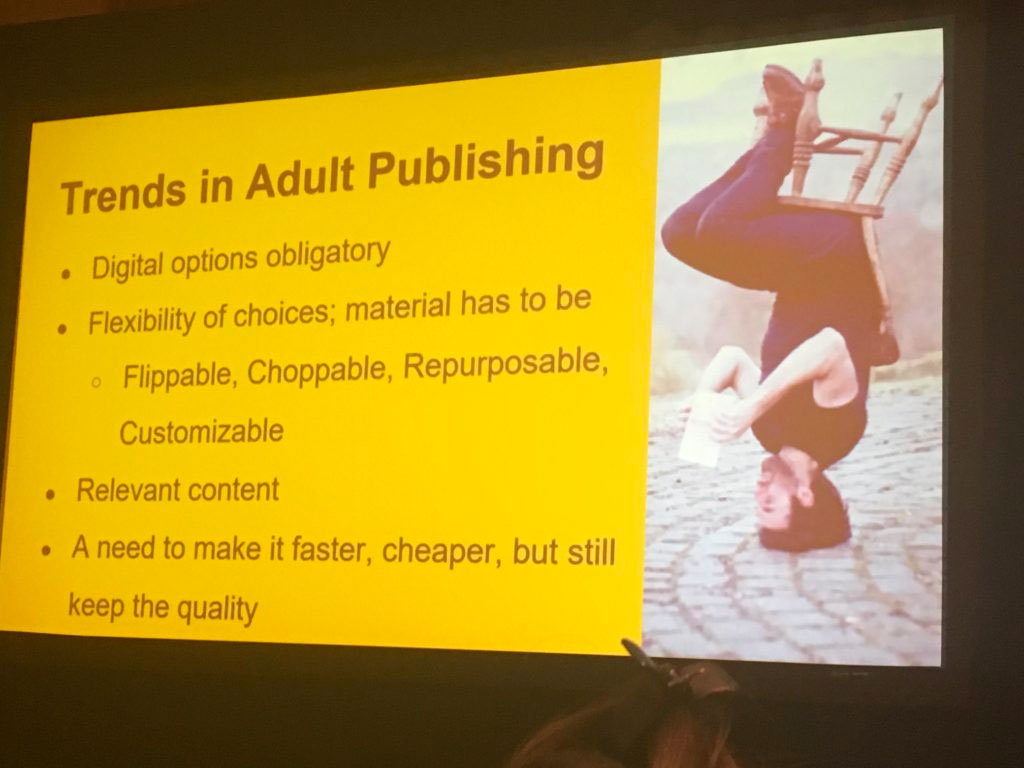Share this post
TESOL 2019 Sessions
The annual TESOL convention is the perfect opportunity for materials writers and editors to learn from the masters and keep up with the changing needs of English language teachers and learners.
Balancing our time between the booth and the classroom is always a struggle at TESOL. While we would love to spend the whole time attending sessions, TESOL is our busiest week of the year! In addition to squeezing a week‑long trip into our busy publishing schedule, we have to present our own sessions, meet with potential partners, and—most importantly—chat with teachers and subscribers in person at the booth.
This year we were fortunate enough to have Ben, Taylor, and Ginny tending the booth throughout the conference. This allowed the publishing team leads to attend more TESOL sessions than ever before.
Here are our top 10 takeaways from sessions we attended at TESOL in Atlanta!

From left to right: Tara (publishing director) & Tanya (managing editor) at TESOL in Atlanta
1. Kahoot! Is a Hoot
We attended several sessions on digital tools where presenters talked about and demonstrated how they used Kahoot! in the classroom. As we continue to make improvements to our own digital platform, we learned the importance of offering a competitive element. Kahoot! can be used for gathering prior knowledge, checking comprehension, and reviewing or assessing content. We love that students can also create their own Kahoots!
“Technology can give learners a voice they may not have had before.”
—Jennifer McGraner
2. Words Are Wordy
In a session by Frances Boyd of Columbia University, we were reminded that knowing a word goes far beyond knowing its meaning and form. Boyd described English as a “combo of high-flown and down-home words.” To really learn a word, students need to notice it, retrieve it, and use and create with it.
Beyond learning the meaning and word form, she suggested that students record syllable stress, multiple meanings, collocations, root, affixes, origin, and more in their vocabulary notebooks (something she requires all of her learners to keep).
Boyd also pointed out that “most textbooks don’t do much after teaching pre‑vocabulary.” Here are four good practices Boyd shared:
- Focus on target words with frequent, short activities.
- Activate learner autonomy (require a vocabulary notebook).
- Create teachable moments (words are everywhere).
- Teach strategies (ignore, infer, investigate).
Boyd also reminded us that students are much more likely to learn a new word in context if they know 90-95% of the words surrounding it. This is a helpful reminder for our materials writers.
“Things that stick in your mind are simple, unexpected, and linked to story.”
—Frances Boyd
3. Students Measure Progress by Speaking Ability
We were wishing an ESL Library representative had been invited to join Joe McVeigh’s publishing panel for the session on Current Trends in ELT Publishing. The panel was made up of leading editors from Pearson, Cambridge, Oxford, National Geographic, and Pro Lingua.
While we would have loved to add our voice, for the most part we felt validated by what the panelists had to share. Rather than following ELT publishing trends over the years, we’ve been setting them! Our subscription-based model that has been in place for the past 17 years is finally being adopted by many of the large publishing houses.
Laura Le Dréan described how ELTs today want more flexibility from publishers rather than the traditional textbook units. Teachers want to be able to “take a little bit of this and a little bit of that” and use digital when it suits them. We thought this described ESL Library pretty well!

Jeff Krum pointed out that one thing publishers often forget is that ELLs measure their progress by how well they can speak. We couldn’t agree more! Our goal for our digital platform is to focus on pair and group speaking practice, and we’re working on many new task types that will give learners more opportunities to speak.
“Anything you measure improves.”
—Jeff Krum
In 2019 we’ll also be working on adding more assessment tasks and tools to our library for both print and digital.
4. Language Learning Projects Offer Student Autonomy
We’ve all had students who need or want extra work. Some are a bit behind their peers while others are way ahead. In an excellent session by Sharon Graham and Deborah Pfeifer, we learned tips on motivating learners to create their own individualized learning plans using these five guidelines:
- goal
- materials
- plan
- method
- criteria for measuring progress
As Pfeifer and Graham demonstrated with their research, students who create their own plans are more likely to follow through.
Watch for an upcoming LLP resource in our Resources section!
5. The Purpose of the Citizenship Test Is Not Just to Pass a Test
In an excellent session by Domminick McParland from the Office of Citizenship, we learned some useful tips about the US Naturalization Test. For the Civics portion of the test, McParland recommended teaching learners thematically rather than just focusing on the 100 questions. As he pointed out, the goal of the test is to prepare immigrants for life in their new country. Rather than just memorizing answers, he suggests teaching learners about the history, geography, and laws of the country they are going to be living in. The English they learn will help prepare them for the other parts of the test.
Check out our Americana Lesson Collection, which has all sorts of theme-based lessons, including an American Citizenship lesson.
On the other hand, McParland pointed out that test day is NOT the day for your students to show off their knowledge. If a question asks for one answer, they should not give more than one. There are no bonus points and the officer decides if the first answer is right or wrong.
The reading and writing portion of the English test is now on a tablet, so it is recommended that teachers include some digital literacy in their lessons. For the writing portion, students have to use a stylus or their finger to write the dictated sentence (they don’t type).
The speaking part is the hardest part. When it comes to the N‑400 form, it is imperative that learners know all of the vocabulary on it. They can’t rely on answering “No” to a question such as “Are you a habitual drunkard?” if they don’t know what the question means. The officer can ask test-takers to explain their answer at any time.
Here are some useful insider tips for preparing your students for the citizenship test:
- Focus on Part 12 of the N‑400 (it’s the most difficult).
- Remind your students to always tell the truth.
- Practice asking an officer to repeat or rephrase a question (and remind students that they are allowed and encouraged to advocate for themselves during the test, including asking for a manager if necessary).
- An abbreviated word will not be accepted for the dictated sentence in the writing section.
- Practice writing with a stylus or finger on a tablet.
- On the reading test, students can fail for pausing too long. Practice reading questions out loud. (Students are not required to answer the question they read out loud.)
6. Grammar Has an Authentic Purpose
We learned some useful tips in a session about grammar and TBLT (Task-Based Language Teaching) by Jennifer Brown, Emma House, Zach Meyer, and Megan Wright. They teach an intensive English program that focuses heavily on grammar practice. Using the TBLT approach, they have integrated real‑world activities into their program, including writing thank-you notes and cover letters, and they base target structures off those tasks (e.g., using gerunds after the phrase “Thank you for…”).
While the jury is still out on just how effective TBLT is for language learners, the presenters found that their students were much more engaged in learning when they used the TBLT approach. Their students appreciated using the grammar as a tool for communicating for an authentic purpose rather than just mindlessly writing down sentences featuring the grammar target.
Our Functional English and Writing sections would be useful for teachers who want to give TBLT a try in their classrooms. For example, teachers could use our Saying Thank You, How to Write a Note, or How to Write a Cover Letter lessons. One of the main goals of our Grammar Practice Worksheets section is to include as many speaking tasks as possible in order to practice the target in a more authentic context.
When it comes to authentic materials, teachers have a habit of pointing out the grammar in context. At higher levels, learners should should be encouraged to identify the targets they’ve learned in the language they encounter. Students can use real-world audio, video, and articles to “spot grammar in the wild.”

7. Suprasegmentals Are Superior
In an informative session on pronunciation, Nihat Polat presented the findings he and colleague Laura Mahalingapappa gathered after a comprehensive review of current pronunciation research. An overall finding was that accuracy should never be the main goal—comprehensibility (overall speech patterns) and intelligibility (how much is understandable) should. This means that our students (and teachers!) should never try to “get rid of” their lovely accent. It might be difficult to convince our students of this, but a reminder might help improve their confidence and refocus their pronunciation goals.
Many teachers conduct pronunciation lessons that focus on only one or two sounds (segmental). Yet another conclusion reached by analyzing current research was that suprasegmentals (intonation, stress, etc.) are more important to pronunciation than segmentals (sounds/words).
While ESL Library’s Phonics & Pronunciation section does include phonics stories with the sounds in context (where students listen and say a story using stress and intonation), the majority of our pronunciation practice is geared towards individual sounds and minimal pairs. We resolved to develop lessons specifically on stress and intonation this year!
8. Explicit Vocabulary Instruction Offers Best Results
Having recently developed a comprehensive lesson on Verb Collocations and with plans to develop many more, we were very interested in attending this well-researched session by Marijana Macis and Suhad Sonbul. Attendees may have been surprised to learn that direct vocabulary instruction (explicit learning) resulted in a much higher retention rate in study after study.
In their own study, the presenters also compared spaced (words repeated several times in a lesson) and massed (words presented only once) learning of vocabulary words. Their results showed that students retained vocabulary through explicit spaced learning to a significantly higher degree that the other conditions. In fact, their students’ scores in the incidental massed condition went down! They surmised that when an item is spaced out, it becomes encoded in memory in different contexts and is therefore better retained in real life.
How can you practice spaced, explicit vocabulary in your classrooms? The presenters suggested using:
- apps
- quizzes
- cumulative tests and assessments
- pair work to discuss previous class concepts/vocabulary
The presenters concluded by saying they found that recycling vocabulary five or more times yielded the highest retention rates.
In our lessons, we almost always include a vocabulary preview, the words in context in the reading, two vocabulary review activities, and the words in context in the listening, so we were happy to hear that the presenters’ findings corresponded to what we do in our materials. And with ESL Library’s new digital platform, there are even more ways to present and practice vocabulary in your classroom!
9. Old-School Grammar Instruction Improves Accuracy
How should you present grammar in class? Should you use grammar notes/charts/instruction or teach it communicatively via grammar in context/task-based activities? This topic has been debated for as long as we can remember. Presenter Richard Oandasan examined past research and then conducted his own study in search of a definitive answer.
Past research results showed that communicative language teaching (CLT) can negatively affect students’ attitudes toward successful language learning. Many studies deemed CLT “insufficient.”
After seven weeks of form-focused grammar instruction, Richard’s study participants demonstrated statistically significant improvements in grammar accuracy.
However, Richard acknowledged that explicit knowledge does not necessarily convert to implicit knowledge of real‑life communicative functions, and he suggested that proficiency in a language is not solely affected by a particular kind of instruction. At ESL Library, we strive to give teachers options on how they can present the grammar target. We include grammar notes/review at the beginning of our Grammar Practice Worksheets lessons (that teachers can choose whether or not to use), while the lessons in our Grammar Stories section show the target in context. Our goal is to provide teachers and students with variety in how they teach and learn grammar.
Richard’s key recommendations were:
- use explicit instructions in grammar classes
- integrate form-focused grammar instructions with communicative activities
As Richard stated, one thing is for sure—students need a lot of grammar practice!
“Output is as important as input.”
—Richard Oandasan
10. Assessment Can Empower Students
Debora Nacamuli Klebs and Esther Vasquez led a lively session on effective assessment and feedback techniques. At ESL Library, we’ve been adding more and more materials to our Assessment Tools resources, so we were delighted to hear how valuable assessment tools can be as well as get some ideas for future resources and lessons during this session.
Here are some the presenters’ key takeaways about assessment:
- Praise effort, not just results.
- There is a difference between not knowing something and not knowing something yet.
- Don’t overdo the praise or overload students with corrections.
- With formative assessment, feedback and adjustments are important.
- Try “two stars and a wish” (i.e., give students two good things and one thing that needs improvement).
- Remember to “close the loop” (i.e., review and recap at the end of the lesson).
- Try using Exit Slips to close the loop.
- Instead of asking “Do you understand?” ask “Which is right, A or B?”
- In tests, try including a “What I studied that you didn’t ask” section for bonus points.
- Believe in your students!

Home of the Braves
We are so grateful to have been able to attend and sponsor TESOL 2019 in Atlanta this year. We always love having the opportunity to meet current subscribers and many other teachers/administrators, give away great prizes, get inspired from all the excellent sessions, and explore a new city.
We are already looking forward to next year’s conference in Denver, Colorado! TESOL 2020 will be a big one for us. It will be Tara’s 10th and Tanya’s 8th TESOL conference. Atlanta will be hard to beat, but we’ve heard great things about the friendly people and fresh mountain air in Denver.
See you next year!
Tara & Tanya
Comments (3)
Tiffany M.(Teacher)
March 26, 2019 at 6:59 am

Tara Benwell(Author)
March 26, 2019 at 5:09 pm
Anonymous A.(Teacher)
March 28, 2019 at 5:33 pm

Tara Benwell(Author)
March 31, 2019 at 10:36 pm
Sabrina D.(Teacher)
March 31, 2019 at 7:39 pm

Tara Benwell(Author)
March 31, 2019 at 10:33 pm

